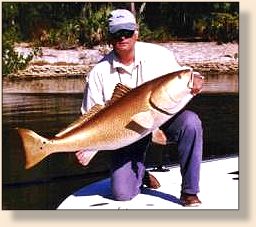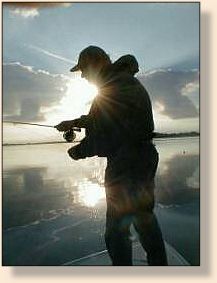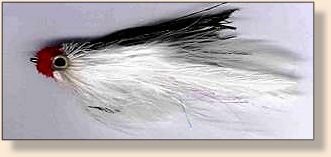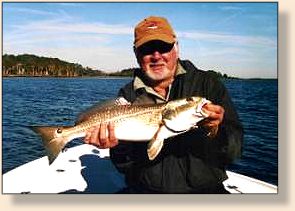"I make it a rule never to weigh or measure a fish I've
caught, but simply estimate its dimensions as accurately
as possible. Then, when telling about it, I improve
those figures by roughly a fifth, or twenty percent.
I do this mainly because most people believe all fishermen
exaggerate by at least twenty percent. So I allow for the
discounting". (Ed Zern, Are Fishermen Really Liars? 1977)
 It was too long ago that I broke my favorite fly rod to this
44-inch, 38-pound beauty. It was probably a world record.
But we had no way to register the fish without taking it out
of the water on a long trip to a certified scale. The redfish
would have certainly died. It was the winter of 1996. That
year, precisely February 24, 1996, Charlie Hogan broke a State
and IGFA world record for his redfish that measured 48.75 inches,
had a 28.75-inch girth and weighed 52 pounds 5 onces. Our
Bogga Grip bottomed out at 30 pounds. So the real weight
was anyone's guess. With redfish, you really can't apply
the Girth to Length ratio to determine weight. It just
won't compute and at the time didn't really matter. I couldn't
kill the fish. So we photographed and released her.
It was too long ago that I broke my favorite fly rod to this
44-inch, 38-pound beauty. It was probably a world record.
But we had no way to register the fish without taking it out
of the water on a long trip to a certified scale. The redfish
would have certainly died. It was the winter of 1996. That
year, precisely February 24, 1996, Charlie Hogan broke a State
and IGFA world record for his redfish that measured 48.75 inches,
had a 28.75-inch girth and weighed 52 pounds 5 onces. Our
Bogga Grip bottomed out at 30 pounds. So the real weight
was anyone's guess. With redfish, you really can't apply
the Girth to Length ratio to determine weight. It just
won't compute and at the time didn't really matter. I couldn't
kill the fish. So we photographed and released her.
Redfish are thick now. Water levels are typically low in the
Mosquito Lagoon at this time of year. And, the redfish are
schooling up tight in the shallows. They feed on shrimp and
mullet. The weather has been mild in comparison to the long
weeks of cold weather last year. With daytime temperatures
in the mid-60s the water stays just below that presents
some interesting challenges for the fly-fisherman.
One good cold snap helped to school the reds and drop the
water level to concentrate them. Figure they wait for a full
moon – the bite will be late. The bite is late because our
tropical climes and mud flats need to warm up before the fish
will become active. If the bait isn't moving nothing else
will either. So, you have to get smart about increasing
your odds of hookups.

Brad and I left later than usual. I wanted to reach the
northeast corner of the basin and pole along the grass edge
to a spot we used to call the blue bucket. The old palmetto
still hangs out over the water and a frayed broken rope hangs
where it once supported that bucket. The air is brisk. Few
shore birds are present. The basin is quiet and still. You
can only feel the silent push from the pole as we move forward.
The sunrise will be spectacular. It always is in the southern
winter.
Using his NTi Redington 9 weight, Brad let his cast settle
on a push along the grass line. He stripped slowly allowing
our JB Mullet Fly to swim in the morning blue. We moved on
studying every ripple and every interruption of the water's
surface. Could that by a push? Is that a tail? We kept on
patiently waiting and watching for signs of a tail or a dorsal,
or a push, anything that would signal they were moving about.
 It is easier to see once the sun is high in the sky. Winter-time
bait usually consists of mullet and they usually swim at the
surface. You'll notice that anglers use Mirro-lures or Excalibers
to attract game fish. It is no different for the fly angler. Top
water flies are the best imitations of bait and usually the flies
that will draw the most strikes and hook ups. You need flies
that make noise and will attract redfish and trout. Borski
sliders are difficult in the cold weather because fish aren't
always feeding on the bottom. When you hear that there is a
mullet run on, go to your top water flies. Besides these flies
are much more fun, because you can see what they are doing in
the water.
It is easier to see once the sun is high in the sky. Winter-time
bait usually consists of mullet and they usually swim at the
surface. You'll notice that anglers use Mirro-lures or Excalibers
to attract game fish. It is no different for the fly angler. Top
water flies are the best imitations of bait and usually the flies
that will draw the most strikes and hook ups. You need flies
that make noise and will attract redfish and trout. Borski
sliders are difficult in the cold weather because fish aren't
always feeding on the bottom. When you hear that there is a
mullet run on, go to your top water flies. Besides these flies
are much more fun, because you can see what they are doing in
the water.
Well that's just what we did. As I polled along I could feel
the sun heating up my jacket. I also knew that the sun was
heating up the mud flats. Soon mullet started becoming active
on top. And, just as soon as we saw the mullet, the redfish
started to move.

"There, Brad, 40 feet, 3 O'clock." Wham! What a hook up!
Just three strips and Brad had a great looking 5-pound redfish.
And, fishing got better after that. It was now 11:30 am and
the bite was ON!
We fished hard for another two hours. The hook ups were great
action and a lot of fun on fly. Stealth and presentation are
always important, but if you get a refusal don't hesitate to
switch patterns. Just remember to be patient and enjoy your
day on the water.
Practice catch and release and don't teach your trash to swim.
~ Doug
About Doug
Capt. Doug Sinclair has relocated from New Smyrna Beach, Florida to
Grantsboro, NC. He specializes in fly-fishing and light tackle charters.
Doug charters the Coastal Carolina area of New Bern or Oriental.
Catch him on the web at
www.flyfishacademy.net or call him at (252) 745-3500.
Doug is also a Sponsor here on FAOL.
|

 It was too long ago that I broke my favorite fly rod to this
44-inch, 38-pound beauty. It was probably a world record.
But we had no way to register the fish without taking it out
of the water on a long trip to a certified scale. The redfish
would have certainly died. It was the winter of 1996. That
year, precisely February 24, 1996, Charlie Hogan broke a State
and IGFA world record for his redfish that measured 48.75 inches,
had a 28.75-inch girth and weighed 52 pounds 5 onces. Our
Bogga Grip bottomed out at 30 pounds. So the real weight
was anyone's guess. With redfish, you really can't apply
the Girth to Length ratio to determine weight. It just
won't compute and at the time didn't really matter. I couldn't
kill the fish. So we photographed and released her.
It was too long ago that I broke my favorite fly rod to this
44-inch, 38-pound beauty. It was probably a world record.
But we had no way to register the fish without taking it out
of the water on a long trip to a certified scale. The redfish
would have certainly died. It was the winter of 1996. That
year, precisely February 24, 1996, Charlie Hogan broke a State
and IGFA world record for his redfish that measured 48.75 inches,
had a 28.75-inch girth and weighed 52 pounds 5 onces. Our
Bogga Grip bottomed out at 30 pounds. So the real weight
was anyone's guess. With redfish, you really can't apply
the Girth to Length ratio to determine weight. It just
won't compute and at the time didn't really matter. I couldn't
kill the fish. So we photographed and released her.
 It is easier to see once the sun is high in the sky. Winter-time
bait usually consists of mullet and they usually swim at the
surface. You'll notice that anglers use Mirro-lures or Excalibers
to attract game fish. It is no different for the fly angler. Top
water flies are the best imitations of bait and usually the flies
that will draw the most strikes and hook ups. You need flies
that make noise and will attract redfish and trout. Borski
sliders are difficult in the cold weather because fish aren't
always feeding on the bottom. When you hear that there is a
mullet run on, go to your top water flies. Besides these flies
are much more fun, because you can see what they are doing in
the water.
It is easier to see once the sun is high in the sky. Winter-time
bait usually consists of mullet and they usually swim at the
surface. You'll notice that anglers use Mirro-lures or Excalibers
to attract game fish. It is no different for the fly angler. Top
water flies are the best imitations of bait and usually the flies
that will draw the most strikes and hook ups. You need flies
that make noise and will attract redfish and trout. Borski
sliders are difficult in the cold weather because fish aren't
always feeding on the bottom. When you hear that there is a
mullet run on, go to your top water flies. Besides these flies
are much more fun, because you can see what they are doing in
the water.